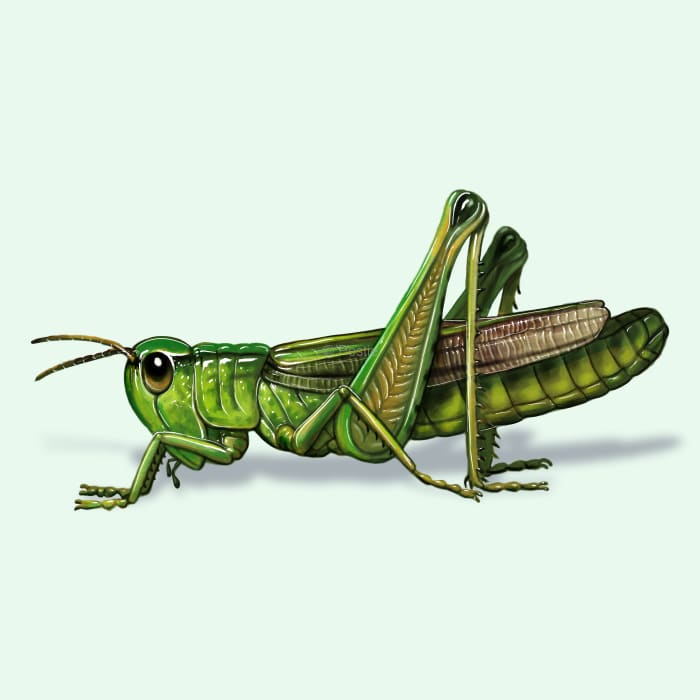How to identify and get rid of grasshoppers

Get the jump on grasshoppers: keeping them out of your home and yard
Grasshoppers have been around for millions of years, but that doesn’t mean we want them hanging out in our homes and yards. These super jumpers belong to an order of insects that include crickets, katydids, and locusts.
Grasshoppers have powerful hind legs that propel them forward to escape attacks and threats. They are herbivores, meaning they eat only plants. Their voracious eating behavior and often large numbers, can be problematic for farmers and gardeners. They have been known to be serious pests on cereals, vegetables, and grasses.
While grasshoppers don’t typically reach plague-like numbers, unlike their locust cousins, the right conditions can create major population spikes for grasshoppers. One day you’ll enjoy the fruits of your labor in your yard and garden and then the next thing you know, you’ve got grasshoppers munching on everything.
Lots of grasshoppers in your yard can eventually spill over into your house. However, there are a few things you can do to keep grasshoppers out of your yard and away from your home.
How to identify grasshoppers
Grasshoppers are the quintessential insect. They have all the typical body parts you would find on a model insect, including three body sections, wings, antennae, and six legs.
One of the distinguishing characteristics of grasshoppers are their strong and long back legs. These are folded up, ready to spring into action, and usually covered in spikes.
Grasshoppers come in all shapes and colors. Some are more camouflaged than others, and some are brightly colored to warn off any predators.
Fun fact
Did you know that researchers found out a way to use grasshoppers to detect explosives? They hook up sensors to the grasshopper’s antennae, and when the grasshopper “smells” the components of a bomb, the sensor detects it. They’ve essentially turned grasshoppers into bomb sniffers!
How to get rid of grasshoppers
Grasshoppers aren’t usually a problem in our homes, yards, or gardens, but under the right condition, they can do quite a bit of damage to our plants.
To combat these pesky pests, you can manually remove the grasshoppers from your home or landscaping by hand picking them and squashing them. Or if the grasshoppers are really bad, you can cover your outdoor plants with metal screening. Cloth covers are often chewed through and aren’t recommended for preventing grasshopper damage.
If you want more passive protection from invading grasshoppers, then an insect barrier or repellent can be handy. Just spray and maintain a bug-barrier around your garden, foundation, and yard.
To remove them from your home, you can vacuum them up or manually remove them outside. Make sure to check for gaps or holes in the exterior of your home. Grasshoppers can sometimes wander inside through open doors or windows. Window screens or screen doors can prevent them from entering your home.
An insect barrier, like the one Pestie offers, can be applied inside and outside the home, keeping grasshoppers from invading your indoor areas. A Pestie subscription gives you pro-grade protection all year long without dealing with a pest control company.
What do grasshoppers eat?
Grasshoppers are primarily herbivores, eating a wide variety of plants. When their numbers get large enough, they can become a significant pest on grains, vegetables, and forages. They eat the leaves, flowers, stems, and sometimes seeds of plants.
However, grasshoppers are exclusively plant eaters. If they need extra protein, they might scavenge on dead insects or even eat each other during swarming or scarce food.
Treat grasshoppers with Pestie
If you're still having trouble keeping grasshoppers away, the best option is to use a pro-grade, effective pest control solution like Pestie.
Pestie is a do-it-yourself pest control solution that's specially designed to keep grasshoppers and other pests away from your home.
With Pestie, you can rest easy knowing that your living space is protected and free of creepy crawlies. And the best part? It's designed for people, pets, and the planet, so you can say goodbye to harsh chemicals and hello to peace of mind!
- Save hundreds compared to traditional annual pest plans
- People, pet, and planet-friendly
- Pro-grade customized formulas








